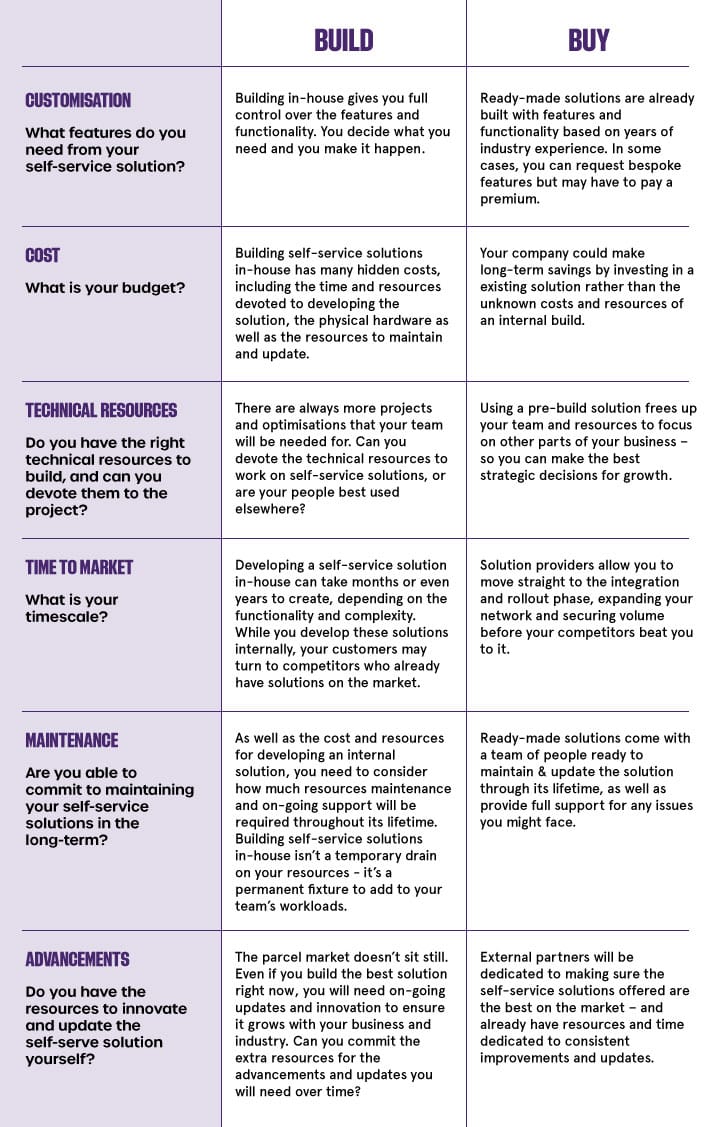Insight / Blog
Should carriers and posts “DIY” their self-service solutions?

Summary: Carriers and posts should invest in self-service solutions. But is building in-house the best option?
Self-service solutions, such as automated lockers and kiosks, are high on carriers and post priority lists. It’s easy to see why, as the automated journeys deliver a great customer experience while reducing staff dependency. What’s more, they also provide an opportunity to expand out-of-home networks in locations that couldn’t previously be served by traditional PUDO, such as coffee shops.
Investment in this area is worthwhile for carriers and posts, but is it something they should use an external company to partner with, or should they build the solution in-house? The natural temptation might be to go in-house, but that might not be the best idea for self-service, as we’ll explain below.
DIY does have its benefits…
Creating a self-service solution in-house does have its benefits. For one, carriers and posts will retain complete control over the design, use and functionality. This gives them complete freedom to build something that perfectly matches the existing infrastructure and solutions they already use, rather than try to integrate and mould external software. In other words, rather than trying to fit a square piece into a round hole, carriers can try to make a perfect circle.
In addition, carriers and posts have the potential to build a self-service solution that is different from other solutions on the market, making it a great way to differentiate your services, capture volume, and increase market share.
…But there are many downsides to DIY
Building anything from the ground up takes a lot of time and resources, both in creating the initial MVP (minimum viable product) and maintaining and improving it through its lifetime.
The more time you spend making the product, the more chance you give competitors to beat you to the punch. If you’re just starting to build now, you’re years behind other companies already on the market – particularly those that have committed their entire existence to building these solutions, like our hardware partners Kiosk, who have been designing and building self-service solutions since 1993. That’s 30 years of experience with a single-minded focus, something carriers and posts won’t be able to replicate in mere months.
How we partnered with the world’s largest retailer & logistics company to improve the parcel stop off experience.
External solutions have the immediate edge
Self-service solutions from an external provider are already made, tried and tested through millions of transactions. So, rather than getting an MVP, you’re getting a refined solution backed by real data – and in just a fraction of the time that building internally requires.
Rather than spending months (or years) perfecting an internal self-service solution, you can get an industry-leading product rolled out within weeks, white-labelled with your branding and customisation.
In the long-term, buying a solution can also be incredibly cost-effective as you will save on the upfront development costs, ongoing maintenance and months of team resources required to build internally. You’ll be able to reallocate those resources to other areas of your business for greater strategic growth.

At Doddle, we’ve always had an interest in self-service solutions. Our kiosk started in 2017 as just a tablet with a bag to drop off items. We quickly changed the bag to a bin, then turned it into our first all-in-one kiosk and deployed it with M&S in the UK over the next few years.
In 2020, our big breakthrough came when a major US retailer approached us for a proof of concept with them across 5 stores in the Seattle area for 6 months in September 2020 – before launching in over 400 locations across US, achieving a 15% increase of parcel volume week-on-week within its early deployment.
During this proof-of-concept phase, we took the kiosk from the MVP to the industry-leading solution, implementing enhancements such as a consumer touch screen, an insert to make it easier to empty, a more robust structure so it wouldn’t get damaged in transport, better components (such as scanners and printers), increased accessibility optimisations such as a headphone jack and navigation pad for full ADA (Americans with Disabilities Act) compliance.
In 2022, we processed over 3 million parcels, with some of our busiest sites reaching 500+ returns per day. Using this data, we were able to further optimise and update the consumer journey to reduce transaction time and increase consumer satisfaction, achieving a CSAT score of 2.8/3.

In Japan, rising labour costs have led stores to test PUDO solutions that are more self-service than traditional operations. With space at a premium, we worked with our partner to develop a lightweight and adaptable countertop kiosk variation, which could handle drop-offs in less than 30 seconds.
We’re not here to say that no other solution is viable or that we always know best. But we have years of testing and experience under our belts. We’ve had the head start, and we can share the hard-earned insights from that experience with our partners, saving them valuable time, resources and effort as we continue to upgrade our solutions and add new products to the range, such as our upcoming outdoor kiosks and through-the-wall options.
To be the first to know about upcoming developments, make sure you’re subscribed to our newsletter.

Related articles
How 3PLs Can Cut Costs, Reduce Waste and Boost Revenue With Smart Returns Management
3PLs should take advantage of returns to help reduce cost, efficiently manage warehouse resources, and aid growth.
Saving profits and the planet: 4 ways to sustainable & cost-effective returns
Returns drain profits and damage sustainability. Luckily, retailers can implement both cost-effective and sustainable returns using these 4 ways.
Speedy refunds: creating happy customers through fast & effective returns
Find out how speedy refunds can recapture revenue, increase customer loyalty and boost lifetime value.











